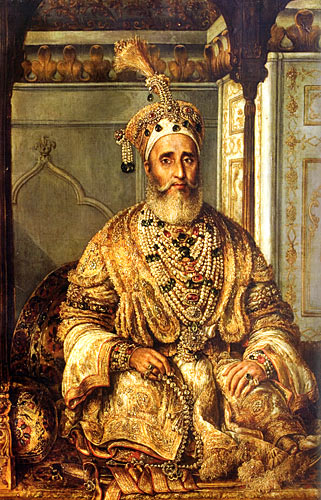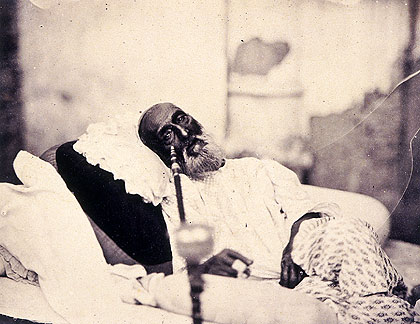
Recently I was talking to a friend in Malaysia and she asked me to define what does farce means and I was startled at her question first and that of telling her that it means a ridiculous situation but then I asked her to wait until the weekend and read my blog to have a better incite on the word.
The last Mughal Emperor of India Bahadur Shah Zafar asscended the throne in 1837 when he was little over 60 years of age. He was last in the lineage of Mughal emperors who ruled over India for about 300 years. Bahadur Shah Zafar was a weak ruler who came to throne when the British domination over India was strengthening and the Mughal rule was nearing its end. The British had curtailed the power and privileges of the Mughal rulers to such an extent that by the time of Bahadur Shah Zafar, the Mughal rule was confined to the Red Fort. Bahadur Shah Zafar was obliged to live on British pension, while the reins of real power lay in the hands of the East India Company. It was at the time of Bahadur Shah that the War of Independence in 1857 started. In Bahadur Shah Zafar the freedom fighters found the symbol of freedom and therefore nominated him as their Commander-in-Chief. In the initial stages, the freedom fighters were successful, but later on the strong and organized British forces defeated them. Bahadur Shah, who had been proclaimed as an emperor of whole of India, was overthrown. He was arrested from Humayun’s tomb, in Delhi, where he was hiding with his three sons and a grandson. Captain Hodson killed his sons and grandson and their severed heads were brought before him. Bahadur Shah Zafar himself was tried for treachery. He was exiled to Yangoon in Myanmar, in the year 1858 where he lived his last five years and died in 1862 at the age of 87.
As of the trial of the last Emperor of India many questions rise in my mind and I keep pondering I may be right and I may be wrong but in my opinion ony I feel that had Bahadur Shah Zafar been conversant with international law, he might have questioned the very legitimacy of the trial he was made to face. The last Mughal was charged with sedition which means acting rebelliously and promoting rebellion against the government. Now my first question is that who comprised the government of India in 1857? If technically to be evaluated then wasn’t it Bahadur Shah himself. He was the Emperor of India, and though he had lost all power, he was the legal ruler of the country. The East India Company was only an agent of the Mughal emperor, that status having been given to it by Shah Alam in 1764.
If my above argument has some credence so how could the emperor be charged with sedition and was he rebelling against his own government? The Company could have abolished the title of Badshah as suggested by Lord Dalhousie but it chose not to. Bahadur Shah was past 80, and was ailing. The Company preferred to wait for the death of the emperor to remove the legal anomaly which recognized the Mughal emperor as a de jure ruler while the Company constituted the de facto government. The East India Company and the British Government shouted their lungs out that the Mughal Emperor alldued to recalcitrance but if to be fair in the eyes of the justice I fail to understant that even the so called mutiny could not be considered a mutiny as the sepoys did not revolt against the sovereign of the land i.e. Bahadur Shah; when the army denied the authority of the Company, it appealed to the Emperor to resume his sway. However, these finer legal points were not raised before the commission constituted by the company to hold Bahadur Shah’s trial. The emperor was not provided with legal assistance. He was too old and infirm to understand the implications of the trial at which he was pronounced guilty and exiled to Rangoon.

Now coming back to the topic that should I not describe the trial of Bahadur Shah as a farce? If a little research be done then it will be evident that there was no danger to the government and that there was no need to introduce the harsh measures against Indians advocated by some Englishmen and it be full with criticism which at that time seemed vulgar and monotonous, but which we must now pronounce to be wicked and blasphemous. For what could be more foolhardy than to assert that external circumstances had granted us a right to destroy a nation in our fury? — to slay and burn, and plunder, not in the cause of order and civilization, but in the name of our insatiable vengeance, and our imperial displeasure. I hope I made myself clear on the meaning of farce.
Photograph Courtesy Wikipedia


I appreciate you for such a smart write up. summarizing history in general and Great Mughal Empire in particular was never easy, yet made possible in this blog.
BSZ picture “in captivity” brought misery to his life till end and tears in my eyes, which reminded me one of his greatest stanza..
Khayal Kiss Ka Samaya Hay, Deeda o Dil Main
Na Din Ko Chain Mujhay, Aur Na Shab Ko Khwaab Aaya
Overall a very nicely written and subject/title of the blog takes my heart…what a circus?